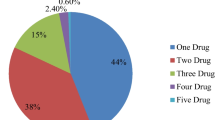Abstract
Background The prescription is one of the factors that influences rational use of medicines. The evaluation of prescribing indicators should contribute to organization of primary health care services. Objective The aim of this study was to evaluate prescribing indicators and associated factors in primary health care in the northeast health district, Belo Horizonte, Brazil. Setting Twenty primary health care units in the Northeast Health District, Belo Horizonte, Brazil. Method The study was cross sectional. Indicators proposed by World Health Organization were used to evaluate rational use of medicines. Main outcome measure Indicators evaluated were average number of medicines per prescription, proportion of medicines with antibiotic, injectable, medicines prescribed by generic name and medicines present in the essential medicines list. Results Three hundred and ninety-nine patients were interviewed. The average number of medicines per prescription was 3.5 (SD 2.2). The proportion of medicines with antibiotic, injectable, medicines prescribed by generic name and medicines present in the essential medicines list was 17.8, 9.8, 94.9, 91.4%, respectively. Patient age ≥60 years was positively associated with number of medicines per prescription (P = 0.00). Conclusion In the northeast health district of Belo Horizonte, the proportion of prescriptions of antibiotics and injections, the adoption of prescribing by generic name and the prescribing of essential medicines were satisfactory in this study considering reference values for these indicators and international scientific literature. However, the mean number of prescribed medicines requires a more in-depth evaluation.
Similar content being viewed by others
References
Pan American Health Organization. Renewing primary health care in the Americas: a position paper of the Pan American Health Organization. Washington: PAHO; 2007. http://apps.who.int/medicinedocs/documents/s19055en/s19055en.pdf. Accessed 10 June 2017.
World Health Organization. The rational use of drugs: report of the Conference of Experts Nairobi, 25–29 November 1985. Geneva: WHO; 1987. http://apps.who.int/medicinedocs/documents/s17054e/s17054e.pdf. Accessed 10 June 2017.
Management Sciences for Health. Managing access to medicines and health technologies. Arlington: Management Sciences for Health; 2012. http://apps.who.int/medicinedocs/documents/s19577en/s19577en.pdf. Accessed 10 June 2017.
World Health Organization. The world medicines situation 2011. Geneva: WHO; 2011. http://www.who.int/medicines/areas/policy/world_medicines_situation/WMS_ch6_wPricing_v6.pdf. Accessed 10 June 2017.
Chaturvedi VP, Mathur AG, Anand AC. Rational drug use—As common as common sense? Med J Armed Forces India. 2012;68(3):206–8.
Howard RL, Avery AJ, Slavenburg S, Royal S, Pipe G, Lucassen P, et al. Which drugs cause preventable admissions to hospital? A systematic review. Br J Clin Pharmacol. 2007;63(2):136–47.
Sultana J, Cutroneo P, Trifirò G. Clinical and economic burden of adverse drug reactions. J Pharmacol Pharmacother. 2013;4(Suppl1):S73–7.
World Health Organization. How to investigate drug use in health facilities: selected drug use indicators. Action Programme on Essential Drugs. Geneva: World Health Organization; 1993. http://apps.who.int/medicinedocs/en/d/Js2289e/. Accessed 10 June 2017.
World Health Organization. WHO operational package for assessing, monitoring and evaluating country pharmaceutical situations: guide for coordinators and data collectors. Geneva: WHO; 2007. http://www.who.int/medicines/publications/WHO_TCM_2007.2.pdf. Accessed 10 June 2017.
Ofori-Asenso R, Brhlikova P, Pollock AM. Prescribing indicators at primary health care centers within the WHO African region: a systematic analysis (1995–2015). BMC Public Health. 2016;16:724.
Dumoulin J, Kaddar M, Velásquez G. Guide to drug financing mechanisms. Geneva: World Health Organization; 1998. http://apps.who.int/medicinedocs/en/d/Jh2928e/. Accessed 10 June 2017.
Harvard Medical School and Harvard Pilgrim Health, World Health Organization. Using indicators to measure country pharmaceutical situations Fact Book on WHO Level I and Level II monitoring indicators. Geneva: World Health Organization; 2006. http://www.who.int/medicines/publications/WHOTCM2006.2A.pdf. Accessed 10 June 2017.
Holloway KA, Ivanovska V, Wagner AK, Vialle-Valentin C, Ross-Degman D. Have we improved use of medicines in developing and transitional countries and do we know how to? Two decades of evidence. Trop Med Int Health. 2013;18(6):656–64.
Desalegn AA. Assessment of drug use pattern using WHO prescribing indicators at Hawassa University teaching and referral hospital, south Ethiopia: a cross-sectional study. BMC Health Serv Res. 2013;13:170.
Emmerick IC, Luiza VL, Pepe VL. Pharmaceutical services evaluation in Brazil: broadening the results of a WHO methodology. Cien Saude Colet. 2009;14(4):1297–306.
Dong L, Yan H, Wang D. Drug prescribing indicators in village health clinics across 10 provinces of Western China. Fam Pract. 2011;28(1):63–7.
Siddiqi S, Hamid S, Rafique G, Chaudhry S, Ali N, Shahab S, et al. Prescription practices of public and private health care providers in Attock District of Pakistan. Int J Health Plann Manage. 2002;17(1):23–40.
Secretaria Municipal de Saúde de Belo Horizonte. Plano Municipal de Saúde 2014-2017 [Municipal Health Plan 2014-2017]. Belo Horizonte: Secretaria Municipal de Saúde de Belo Horizonte; 2014.
Farias AD, Cardoso MAA, Medeiros ACD, Belém LF, Simões MOS. Indicadores de prescrição médica nas unidades básicas de Saúde da Família no município de Campina Grande, PB [Prescription indicators in Family Health basic units of the municipal district of Campina Grande, PB]. Rev Bras Epidemiol. 2007;10(2):149–56.
Lima-Costa MF, Matos DL, Camargos VP, Macinko J. Tendências em dez anos das condições de saúde de idosos brasileiros: evidências da Pesquisa Nacional por Amostra de Domicílios (1998, 2003, 2008) [10-year trends in the health of Brazilian elderly: evidence from the National Household Sample Survey (PNAD 1998, 2003, 2008)]. Cien Saude Colet. 2011;16(9):3689–96.
Ojo MA, Igwilo CI, Emedoh T. Prescribing patterns and perceptions of health care professionals about rational drug use in a specialist hospital clinic. J Public Health Afr. 2014;5(2):242.
Funding
None.
Conflicts of interest
None.
Author information
Authors and Affiliations
Corresponding author
Rights and permissions
About this article
Cite this article
Lima, M.G., Dutra, K.R. & Martins, U.C.M. Prescribing indicators in primary health care in Belo Horizonte, Brazil: associated factors. Int J Clin Pharm 39, 913–918 (2017). https://doi.org/10.1007/s11096-017-0501-z
Received:
Accepted:
Published:
Issue Date:
DOI: https://doi.org/10.1007/s11096-017-0501-z



